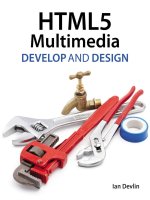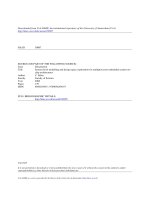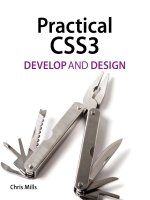peachpit press applied jquery develop and design
Bạn đang xem bản rút gọn của tài liệu. Xem và tải ngay bản đầy đủ của tài liệu tại đây (12.22 MB, 274 trang )
ptg
ptg
Jay Blanchard
Applied jQuery
DEVELOP AND DESIGN
ptg
Applied jQuery: Develop and Design
Jay Blanchard
Peachpit Press
1249 Eighth Street
Berkeley, CA 94710
510/524-2178
510/524-2221 (fax)
Find us on the Web at: www.peachpit.com
To re p ort erro rs, please send a note to: erra ta@pea chpit.co m
Peachpit Press is a division of Pearson Education.
Copyright © 2012 by Jay Blanchard
Editor: Rebecca Gulick
Development and Copy Editor: Anne Marie Walker
Te chnical Re v i ewe r : Jesse R. Castro
Production Coordinator: Myrna Vladic
Compositor: Danielle Foster
Proofreader: Patricia Pane
Indexer: Valerie Haynes-Perry
Cover design: Aren Straiger
Interior design: Mimi Heft
Notice of Rights
All rights reserved. No part of this book may be reproduced or transmitted in any form by any means,
electronic, mechanical, photocopying, recording, or otherwise, without the prior written permission of the
publisher. For information on getting permission for reprints and excerpts, contact
Notice of Liability
The information in this book is distributed on an “As Is” basis, without warranty. While every precaution has
been taken in the preparation of the book, neither the author nor Peachpit Press shall have any liability to any
person or entity with respect to any loss or damage caused or alleged to be caused directly or indirectly by the
instructions contained in this book or by the computer software and hardware products described in it.
Trademarks
Many of the designations used by manufacturers and sellers to distinguish their products are claimed as
trademarks. Where those designations appear in this book, and Peachpit was aware of a trademark claim,
the designations appear as requested by the owner of the trademark. All other product names and services
identified throughout this book are used in editorial fashion only and for the benefit of such companies with
no intention of infringement of the trademark. No such use, or the use of any trade name, is intended to
convey endorsement or other affiliation with this book.
ISBN 13: 978-0-321-77256-5
ISBN 10: 0-321-77256-3
9 8 7 6 5 4 3 2 1
Printed and bound in the United States of America
ptg
To Mom, who taught me there was magic in books,
and to Dad, who taught me there was magic in me.
ptg
IV APPLIED jQUERY: DEVELOP AND DESIGN
Projects like this are not possible without the support and understanding of a lot of
people, something I really didn’t understand when first embarking on the journey
to create a book. Saying “thank you” isn’t nearly enough, but I hope that you all
understand how much I appreciate you!
Even with the blender of life roaring around us, Connie Kay, Kaitlyn, Brittany,
Zach, Karla, and Morgan provided more love and support than you can imagine.
I love you all!
To R e be cca G u l ic k , th an k y o u fo r b e l ie v in g in me a n d h e l pi ng a d ream to com e t r u e!
To An ne Ma rie Walker, e nou gh cannot be sa id ab out your ge ntle fir mne ss,
guidance, and subtle humor. I am eternally grateful to you!
To Jesse Cast ro, tha nks fo r keep ing m e on t he s trai ght a nd na rrow. Your i ns ight ,
technical abilities, and encouragement blow me away!
To La rr y Ul lm an, t ha nk s fo r bei ng t he Fo rd Prefec t to my Art hur Dent a nd g ui d-
ing me through the galaxy! I kept my towel on my desk the whole time!
To Fran cis G overs , the t wist s and t urn s in my li fe a re m ade a ll th e more b ear-
able by knowing that you are just a phone call or an e-mail away. Best friends don’t
get any better!
To th e folk s who h ave mad e up th e tea ms of d eve lop ers t hat I have wo rked w it h
day in and day out, thank you for making me a better programmer and a better
person! Your willingness to look over my shoulder and teach me something new
is treasured beyond measure.
To t he jQu er y co mmu nit y, yo u are an ama zin g g roup of p eop le , an d I am hon -
ored to share electrons with you!
ACKNOWLEDGMENTS
ptg
CONTENTS V
Introduction viii
Wel come t o jQue r y xi
1 INTRODUCING JQUERY XIV
Making jQuery Work 2
Wor kin g wit h the D OM 6
Learning a Few jQuery Tips 9
Selecting Elements Specifically 9
Making Quick Work of DOM Traversal 10
Troubleshooting with Firebug 10
Packing Up Your Code 11
Using Return False 15
Fiddling with jQuery Code . . . . . . . . . . . . . . . . . . . . . . . . . . . . . . . . . . . . . . . . . . . . . 16
Combining jQuery with Other Code 18
Starting with HTML 18
Styling Web Pages with CSS 18
Using PHP and MySQL 18
Progressive Enhancement 19
Planning Design and Interaction 23
Wrapping Up 23
2 WORKING WITH EVENTS
Using the Photographer’s Exchange Web site 26
Making Navigation Graceful 27
Creating and Calling Modal Windows 27
Binding Events to Other Elements 34
Building an Image Carousel 34
Creating Sprite-based Navigation 50
Wrapping Up 57
3 MAKING FORMS POP
Leveraging Form Events 60
Focusing on a Form Input 60
Va l i d a t i n g E m a i l A d d re s s e s 62
Making Sure an Input Is Complete 66
Tackling Uploads 69
Performing Client-side Validation 69
CONTENTS
ptg
VI APPLIED jQUERY: DEVELOP AND DESIGN
Developing Server-side Validation 72
Uploading Files 74
Wrapping Up 89
4 BEING EFFECTIVE WITH AJAX
Using AJAX for Validation 92
Building the PHP Registration and Validation File 92
Setting Up the jQuery Validation and Registration Functions 100
Logging in the User 105
Using AJAX to Update Content 108
Getting Content Based on the Current User 108
Loading Content Based on Request 110
Loading Scripts Dynamically 112
Using jQuery’s AJAX Extras 116
Using JSON 126
Securing AJAX Requests 134
Preventing Form Submission 135
Using Cookies to Identify Users 139
Cleansing User-supplied Data 141
Transmitting Data Securely 144
Wrapping Up 145
5 APPLYING JQUERY WIDGETS
Using the jQuery UI Widgets 148
Customizing the jQuery UI 148
Including jQuery UI Widgets 152
Using jQuery Plugins 171
Beefing Up Your Apps with Plugins . . . . . . . . . . . . . . . . . . . . . . . . . . . . . . . . . . . 172
Pumping Up Your Sites 188
Rolling Your Own Plugins 200
Wrapping Up 203
6 CREATING APPLICATION INTERFACES
Establishing the Foundation 206
Creating the HTML 207
Applying the CSS 209
Making the Interface Resizable . . . . . . . . . . . . . . . . . . . . . . . . . . . . . . . . . . . . . . . 214
ptg
CONTENTS VII
Improving the Application Interface . . . . . . . . . . . . . . . . . . . . . . . . . . . . . . . . . 217
Creating Better Sprites 217
Loading Content with AJAX 226
Configuring Additional Enhancements 235
Wrapping up 247
Index 248
ptg
VIII APPLIED jQUERY: DEVELOP AND DESIGN
As Web designers, you are painstakingly compelled to grab Web surfers’ attention
as quickly as possible and then keep them on your site to absorb the content. In
addition to the product, service, or information that you are providing, the site
must be visually attractive and offer stimulating (and valuable) interaction. The
jQuery library is the main ingredient for providing the icing on your Web-site cake.
If applied well, the effects of jQuery will convince visitors and application users to
click around and sample all of your content.
The trick is learning how to combine jQuery with other markup and languages
effectively. You must gain knowledge in a wide range of disciplines, like HTML
(HyperText Markup Language) and CSS (Cascading Style Sheets), to know how
to properly mix in the right amount of jQuery. The goal of this book is to give you
the knowledge to bring the HTML, CSS, and jQuery ingredients together to create
compelling interactivity to your Web sites and applications.
Throughout the book, I’ll also show you ways to use PHP, a popular server-
side scripting language, and MySQL, a relational database product, to enhance
your overall development and supercharge your applications. Both technologies
translate easily to other Web development languages.
WHAT IS JQUERY?
Announced in 2006 by its creator, John Resig, jQuery quickly gained popularity and
support as a new way to use JavaScript to interact with HTML and CSS. jQuery’s
simple selectors mimicked CSS selectors, making the library familiar and easy
to learn for designers and developers alike. The jQuery library erased the worry
that Web developers had suffered through when trying to create interactive sites
across a wide range of browsers by handling most browser compatibility issues
behind the scenes.
Top pin g off th os e two featu res is th e sho rte ned synta x us ed by j Qu er y. The fo l-
lowing example shows how you would select an element based on its id attribute
using jQuery:
$(‘#foo’);
INTRODUCTION
ptg
INTRODUCTION IX
The jQuery selector is much shorter as opposed to the same example in old-
school JavaScript:
document.getElementByID(‘foo’);
It’s no wonder that the Web-development community embraced jQuery’s “write
less, do more” mantra. Couple the simplicity of jQuery with its ability to support
complex animations and achieve stupendous effects, and you get a JavaScript library
that is flexible and capable of empowering you to provide your Web site visitors
with an outstanding interactive experience.
WHO THIS BOOK IS FOR
This book is aimed at beginning to intermediate Web developers, but it doesn’t
matter where you are in your journey as a designer or developer. You should find
examples in this book that will help you to bring your Web pages and applications to
life with jQuery. It helps if you have a basic knowledge of HTML, CSS, JavaScript, and
jQuery, but it is not necessary because the examples are fully baked and ready to go.
WHAT I USED
As of this writing, jQuery 1.5 had been released and is used for all of the examples
in the book. You can download it at www.jquery.com. It is also available on the
book’s Web site at www.appliedjquery.com.
HTML, CSS, and JavaScript files are all plain-text files that you can create and
edit in any plain-text editor.
Examples were all tested in Firefox 3 and Internet Explorer 8, with an occasional
peek in Safari and Google Chrome.
WHERE TO FIND THE CODE
All of the code examples for the book are available from the Applied jQuery Web
site at www.appliedjquery.com/downloads. There you can download a Zip file con-
taining all of the examples, graphics, and other collateral needed to follow along.
The examples are arranged by chapter within the Zip file and include all of the
necessary jQuery files to make the examples work right out of the box.
ptg
X APPLIED jQUERY: DEVELOP AND DESIGN
However, even though all of the files are available for download, I encourage
you to type out each example as you progress through the book. Taking a hands-on
approach will help you to learn how all of the technologies fit together and will
reinforce the concepts in your brain.
LET’S GET STARTED
It’s time for you to jump right in and get started learning how to use jQuery. In the
first chapter I’ll give you some good rules and tools to get you headed in the right
direction for sweetening your Web development efforts with jQuery.
ptg
i
WELCOME TO
jQUERY
ptg
XII APPLIED jQUERY: DEVELOP AND DESIGN
WELCOME TO jQUERY
jQuery is one of the most popular JavaScript libraries in use today because it lets you
build JavaScript Web pages and Web applications quickly and easily, accomplishing in a
single line of code something that would have required dozens of lines of JavaScript code.
Grab yourself a computer and the handful of tools outlined below, and then dig into the
following six chapters.
jQUERY
jQuery, which is free to
download and use, comes
in the form of a single .js
le that you link to from
your Web page, and your
code accesses the library
by calling various jQuery
functions. Go to jquery.
com and download the
jQuery library.
jQUERY UI
Next, you’ll want to
download the jQuery UI
library from jQueryUI.com.
This will equip you with
some core interaction
plugins as well as many
UI widgets that I’ll discuss
later in the book.
TEXT EDITOR
You’ ll be doi ng s ome
scripting, so get yourself a
good text editor. Windows
users typically opt for
Microsoft Notepad or
Notepad++, while Mac
users often rely on BBEdit
from Bare Bones Software.
ptg
BROWSER
Chances are you’ve
already got a standards-
compliant browser
installed. Popular options
are the latest versions
of Microsoft Internet
Explorer, Mozilla Firefox,
Apple Safari, Google
Chrome, and Opera.
TROUBLESHOOTER
I rely heavily on the
Firebug Web development
tool for troubleshooting.
Go to http://getrebug.
com and get a version
that’s specic to your
browser. It’s 100% free
and open source, and
you’ll be grateful you’ve
got it installed when
something goes wrong.
TESTING
ENVIRONMENT
Rather than using an
actual hosted Web site
totest your jQuery
creations, use a testing
environment that’s local
on your own computer.
Iuse XAMPP, which you
can download from
.
WELCOME TO jQUERY XIII
ptg
1
INTRODUCING
jQUERY
ptg
Rich, interactive Web sites that use semantic
markup and unobtrusive technologies like Cas-
cading Style Sheets (CSS) and JavaScript are becoming the
de facto standard in Web development. Designers and developers
are looking for new and better ways to bring their creations to life,
and libraries like jQuery make this goal easily attainable.
To get started properly with jQuer y, you nee d to equip yourself
with the appropriate tools and concepts. So, I’ve gathered those
tools for you and will help you to learn how to use them.
This chapter will give you a firm grasp of the basics of jQuery and
the tools that will make working with jQuery straightforward. Also
included are some tips for getting the most out of jQuery. But first
things first; let’s start with a “Hello World” example jQuery style.
ptg
CHAPTER INTRODUCING jQUERY
The strength of the jQuery library is its ability to interact with elements in your
Web p ages t hat yo u are alre ady fa mil iar w ith . Mar ku p tag s, cl ass d ecl arati ons , and
attribute information in your Web pages can be easily connected to jQuery by using
the simple concept of selectors.
A jQuery selector will wrap an element or set of elements into an object. Once
you have created the jQuery object, you can effectively apply a multitude of jQuery
methods to that object to create animations, send information to and from the
server, or perform object manipulation.
No book on programming is worth its salt if it doesn’t have a “Hello World!”
example. To illustrate the power and flexibility of jQuery’s selectors, let’s create a
“Hello World!” example.
1. Start by establishing the basic markup for the HTML page:
<!DOCTYPE>
<html lang=”en”>
<head>
<meta charset=”utf-8” />
<title>Hello World - jQuery Style</title>
2.
Be sure to include the jQuery source file. Without this file none of the
jQuery code will operate:
<script type=”text/javascript”
p
src=”jquery-1.5.min.js”></script>
3. Open a script tag to give the jQuery code a place to live within the page:
<script type=”text/javascript”>
: The Hello World code is the only code example not available in
the download from the book’s Web site. The reason is that I think it
is very important that you type this one in yourself. Comments are also
included in the example.
MAKING jQUERY WORK
ptg
MAKING jQUERY WORK
4.
The jQuery functions that you are creating need to be available to run after
the Web page has finished loading all of its elements. To accomplish this,
you wrap the jQuery code in a document ready function. Just as it implies,
the code wrapped in the function becomes available to run when the Web
document is ready:
$(document).ready(function() {
5. Create the first selector. This selector will get the markup element in the
page having an
id
attribute equal to
first
. All
id
attributes are selected
in jQuery (and CSS) by prepending the hash (
#
) sign to the information
contained within the id attribute. You’ll follow the selector with jQuery’s
html
method by chaining the
html
method to the selector. This method
will place the markup <h1>Hello World!</h1> into the selected element:
/* write ‘Hello World! to the first div */
$(‘#first’).html(‘<h1>Hello World!</h1>’);
Chaining is the term used to describe applying one or more methods to
jQuery objects. Chaining gives you a wide variety of possibilities to combine
methods to create unique interactions for your Web-site visitors.
6.
For this example, you’ll create one additional method that connects, or
binds, an event handler to a selector to create an action. The event handler
will accept an action and perform additional jQuery functions to other
selected elements. Start this portion of the example by binding jQuery’s
click handler to an element with an id of link:
/* a clickable ‘Hello World!’ example */
$(‘#link’).click(function() {
The click method exposes a handler function that allows you to build a
string of actions that will be triggered by the click method.
7. Set up a selector for the element with an id of greeting and apply the html
method to it:
$(‘#greeting’).html(‘<h1>Hello Again!</h1>’);
ptg
CHAPTER INTRODUCING jQUERY
8. Close out the jQuery code with the proper braces, brackets, and script tags:
});
});
</script>
Pay close attention to braces and brackets when you create jQuery code. It
is critically important that each opening bracket or brace have a matching
closing bracket or brace.
9.
Finish up the
head
section of the markup and open the
body
of the Web page:
</head>
<body>
10. Create an HTML div with an id of first. The initial jQuery selector that
you created previously will interact with this element, adding the HTML
markup that was specified between the
div tags:
<div id=”first”></div>
11. Create another HTML div with an id of second. You did not write any selec-
tors for this element; it is just being used as a container for other elements:
<div id=”second”>
12.
Create an anchor tag and give it an
id
of
link
. You wrote jQuery code earlier
that will handle the link when it is clicked by a user:
<a href=”#” id=”link”>Click Me!</a><br />
13.
Create a span element with an
id
of
greeting
. When the link is clicked, the
selector for greeting will apply the HTML markup you specified between
the span tags:
<span id=”greeting”></span>
14. Complete the page by closing out the markup tags properly:
</div>
</body>
</html>
ptg
MAKING jQUERY WORK
15. Save the file as hello_world.html and load it into your Web browser. If you
have been diligent with your typing, you will be rewarded with a Web page
identical to the one shown in Figure 1.1.
This example is just a small taste of how you can connect jQuery to elements
in your Web pages to provide information and interactivity. The example also
demonstrates how you can add elements to your Web pages using jQuery.
To wo rk wit h jQ uer y effect ivel y, yo u ne ed t o kn ow h ow to work wit h a ll of th e
elements in a Web page and how they are assembled into a document.
A document?
That is absolutely correct: Web pages are documents that are intended for
display in Web browsers. Because Web pages are documents, they follow some of
the same rules that paper documents follow, and those rules are provided by the
master document—the Document Object Model (DOM).
FIGURE . The “Hello World!”
message appears when the
page loads, and the “Hello
Again!” message appears
when the link is clicked.
ptg
CHAPTER INTRODUCING jQUERY
At the heart of all of your Web pages is an API (Application Programming Interface)
that describes everything on the page. It is the DOM. The DOM provides informa-
tion for each element on the page, including styles associated with elements. The
information in the DOM is stored in a tree-like structure.
Several DOM inspector applications are available either as stand-alone appli-
cations or as add-ins to many popular Web browsers. Figure 1.2 shows the DOM
inspector available with Firebug.
FIGURE . Examining the
DOM using Firebug with
Firefox.
WORKING WITH THE DOM
ptg
WORKING WITH THE DOM
The DOM API is what allows languages like JavaScript and libraries like jQuery
to interact with elements in your Web pages. You can use libraries like jQuery to
virtually climb up and down the DOM tree to locate, add, remove, and modify ele-
ments. Because you’ll be using jQuery to interact with the DOM, including adding
and removing elements from it, you need to become familiar with how the DOM
is constructed. You don’t need to become an expert on the DOM, but you should
know enough about the DOM to recognize what is going on when you manipulate
it with jQuery.
Knowing the DOM becomes critically important when you start working with
jQuery’s parent and child type selectors. You must understand the relationship
between the elements in the DOM so that you can effectively manipulate those
elements. Consider the following HTML markup:
<div id=”information”>
<ul>
<li><a href=”foo.html”><img src=”bar.jpg” /></a></li>
<li><a href=”glorp.html”><img src=”murkle.jpg” /></a></li>
</ul>
</div>
To k now how t o travel up a nd d own the DOM tree , you mus t kn ow wh at th e
relationships are between the elements. Figure 1.3 shows how those relationships
are defined.
FIGURE . An outline of the
relationships between the
elements in the list.
ptg
CHAPTER INTRODUCING jQUERY
LINE BREAKS AND COMMENTS
Because JavaScript allows you to continue code through line breaks, jQuery
will, too. This means that you can spread chained jQuery methods over sev-
eral lines. Spreading lengthy chains over multiple lines makes the jQuery
methods visually easier to follow and troubleshoot. Quite often you’ll see
jQuery chains similar to the following example:
var nextImage = $(‘img[src=”bar.jpg”]’) // define the
p
starting point
.closest(‘li’) // travel up to the closest list item
.next() // move to the next list item
.find(‘img’) // find the image tag in the next list item
.attr(‘src’); // grab the source attribute of the found
p
image tag
I cannot stress enough the importance of commenting your code well.
Although I won’t be commenting a lot of the code in the book for space rea-
sons, you can expect to see a lot of commentary within the code samples on
the Web site. My personal style is to use the double slash at the end of a line
when the comment is quick and use larger comment blocks (beginning with
/* and ending with */) when I need to be more descriptive.
// is a short comment
/* this comment may span multiple lines and can be very
p
descriptive */
Armed with this knowledge, you can traverse the DOM elements for this list.
Given that you know the image source in the first list item, you can retrieve the
source attribute from the second image in the list easily, like this:
var nextImage = $(‘img[src=”bar.jpg”]’) // define the starting point
.closest(‘li’) // travel up to the closest list item
.next() // move to the next list item
.find(‘img’) // find the image tag in the next list item
.attr(‘src’); // grab the sounrce attribute of the found
p
image tag
The variable nextImage now contains the value murkle.jpg.
ptg
LEARNING A FEW jQUERY TIPS
As I use and continue to learn more about the jQuery library, I’ve accumulated
some good rules of thumb, including being specific about jQuery selectors, cach-
ing selectors, and packing up code to make it more efficient. These and other tips
provided here will make your code more effective, provide you with some good
tools, and shorten your development time.
SELECTING ELEMENTS SPECIFICALLY
To fi nd t he ele ment s t hat yo u wan t to ac t o n, j Que ry ha s to traverse the DOM tree .
Depending on the length and complexity of a page, the DOM can be quite large.
Using grossly formed selectors can slow performance and lead to frustration.
jQuery reads selectors right to left, so if you have a selector like this:
$(“div ul li a”);
jQuery will gather all the anchors first, determine if they are within list items, and
then find out if the list item is contained within an unordered list that is contained
within a <div>.
Whew! It would be better to give one group of these items a class or an id
attribute that will allow you to more directly identify one or more of the elements
involved. For instance, the anchor tags in this group can be navigation elements
and given a class of
navigation (<a href=”nav1.html” class=”navigation”>).
That will allow you to shorten the selector to
$(“.navigation”).
As an added
bonus, the element can be more easily referred to and styled in CSS!
: Thanks go out to the very supportive jQuery community for
the tips included in this section. You can learn a lot by participating
in the jQuery forums at . Forum participants are
always willing to lend a hand to help you solve your jQuery and JavaScript
problems.
LEARNING A FEW jQUERY TIPS
ptg
CHAPTER INTRODUCING jQUERY
MAKING QUICK WORK OF DOM TRAVERSAL
Sometimes, you might need to upgrade a poorly planned older site or application
that was developed by someone else. The selector mentioned in the previous sec-
tion,
$(“div ul li a”), might have to be used repeatedly to achieve the results
that you are trying to apply with jQuery. If that is the case, you should cache the
selector so that you only need to traverse the DOM once for that selector:
var myNavLinks = $(“div ul li a”); // perform the traversal and
p
stores it
$(myNavLinks) // the new selector doesn’t have to traverse the
p
tree again
Caching becomes a valuable performance tool when you want to manipulate
dozens or maybe even hundreds of table rows and cells.
TROUBLESHOOTING WITH FIREBUG
Avail able for nea rly eve ry browse r, Fi rebug is t he leading tool for de bugg ing an d
profiling JavaScript. It should definitely be in your Web development toolbox.
Firebug allows you to carry out several tasks, including watching your code “in
action” to see how it behaves when events are triggered on your Web pages. For
instance, in Figure 1.4 a link has been clicked. If you look closely, you can see that
several lines of HTML have been highlighted in yellow. Those lines are the portion
of the HTML affected by the clicked link.
One of Firebug’s handier features is its ability to identify JavaScript (and therefore
jQuery) errors accurately, allowing you to quickly troubleshoot and correct problems.
I’ll use some of Firebug’s features throughout the book. To talk about and dem-
onstrate all the features Firebug has to offer would take an entire book!
: Firebug is a free download from .









